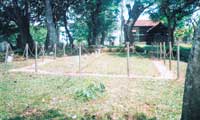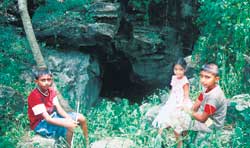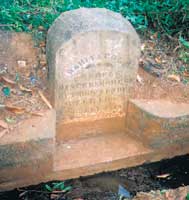
That shameful day in Matale
On the A9 lies the village of Kohombiliwela, about a a kilometre before Matale. The huge Banyan tree, the Kovil and the wafting aura of suburbia all belie the horrendous bloodbath that took place around here 150 years ago. It all happened during the morning hours of July 29, 1848 when a force of about 4000 crudely armed peasantry were presumably heading for Kandy. Around Wariyapola Estate, more than 50 were mowed down, an equal number taken prisoner and hundreds wounded by Captain Lillie and his company of 220 soldiers. The Company had been ordered out the previous night by the Commandant of Kandy at the behest of Govt. Agent Buller and Sampson Waring, Police Magistrate of Matale who, along with the Police stationed there had been driven out by Puran Appu's men. The Matale Rebellion was thus emasculated with a single action. The only British casualty was a soldier wounded at Wariyapola. Lillie was acting under martial-law which gave the military enormous powers. He and his men had marched along the old cart road from Kandy to Matale the previous night. The old cart road roughly coincides with the present rail road; the present A9 highway having been built much later, consequent upon the conversion of the old cart road into the present rail road in 1899. The Ceylon Rifle Regiment comprised entirely of Malays with British officers. The 15th Regiment was all British. These were the units which ambushed Puran Appu. The crescent - topped monolith half buried near the Banyan tree says it all. There is much hidden between the lines. The legend can barely be read. The epigraph which turns out to be an epitaph in the end, reads thus: WARIYAPOLA A Thomas MacLachlan or a MacBuldjana from Wariyapola Estate would have had this erected 61 years later, to glorify Lillie or through a mere desire to record history. The saying that Geography is about maps and History is about chaps comes to mind. The rock cave supposed to have been used by Puran Appu and Gongalegoda is close to the Lillie memorial. The gravel road which borders the kovil crosses the railroad and a temple into a cleared area with a few modern houses and ends abruptly. The cave is on the left flank of the hill with a few Mara trees and wild undergrowth. After a minute or two a hop, step and jump away the explorer is surprised by the cave. Coffee bushes growing wild is a common sight here and evoke memories of a great era 170 years ago.
The loss in terms of human life was about 250 shot or hanged, mostly by court-martial. After the massacre at Wariyapola, Matale was garrisoned by about 110 soldiers of the Ceylon Rifles under Captain Watson. Many more were imprisoned for life, banished, flogged in public or just tortured. British brutality was further epitomized by the shooting down of Ven. Kudapola Sri Rahula, better known as "Kudapola Unnanse" in his holy robes. Albert Watson was the man who, along with Capt. William Fisher discovered Horton Plains on March 28, 1834, whilst out elk hunting. Watson took a leading role in the suppression at Matale. He was 45 then. His conduct therein formed the subject of a Royal Commission of Inquiry, a court-martial, questions, debates and committees in Parliament in London. Capt. Henderson who unsuccessfully went after Gongalegoda at Wariyapola and retrieved pieces of his palanquin, later wrote a book on the Rebellion, which was a severe indictment on Watson, Secretary Tennent and Torrington. However, he supported Waring who was made to retire for not making a stand at Matale. Watson later served in Galle as the Police Superintendent. He retired from the Ceylon Rifles as a colonel and died on November 12, 1896. The son of a retired General, he lies buried at Mahaiyawa Cemetery, in a more dignified manner than the gallant rebels whose graves in and around Matale lie uncommemorated. Sampson Waring who retired on October 1 1848, died on February 28, 1856, aged 60. He too, lies buried at Kandy Garrison Cemetery, no doubt, honoured in a fitting manner. His wife Henrietta who died on January 20, 1872 at 66, is buried there too. The ignominy of seeing the mounded graves of our fallen ancestors who fought against heavy odds, degraded in this manner, vis-a-vis the immortality of the graves of the perpetrators, leaves any Sri Lankan ashamed indeed. A dire necessity today is for the nation to show gratitude to these gallant men and perpetuate their memory for all time.
The peasants in the hills rose against an oppressive ruler who violated the Kandyan Convention of 1815 signed between Brownrigg and his local lackeys. The accomplices responsible for the agony were the Kandyan chiefs, most of whom signed it in Tamil. By 1848 they had already embraced Victorian values. The British Empire headed by Queen Victoria was at its zenith. The Indian Mutiny was nine years away. British Premier Lord John Russell appointed his cousin Viscount Torrington as Governor of Ceylon in 1847. Torrington was an arrogant, hot-tempered and tactless man with no administrative or political experience. He was just 35 and was probably the only one who owed his appointment to influence. Throughout British rule, out of 30 Governors, only two were recalled due to mismanagement. One was Torrington (1847/50) and the other was Chalmers (1913/16). The coffee slump of 1846 produced a budget deficit. To make up for it, Torrington introduced new taxes on shops, boats, carriages, bullock carts, firearms and dogs. The road tax required every inhabitant to work six days annually on road construction or pay a tax of three shillings. The villagers were quite content with jungle paths and regarded the new tax as being a benefit only to the coffee planters. The network of roads in use today was only a very distant pipedream then.
This then was the backdrop in which about 5000 villagers from the interior, dogs in tow, gathered before GA Buller in Kandy on July 6, 1848 to protest. When the crowds turned restive some of Superintendent Colepepper's Policemen were knocked down. Thereafter troops of the 15th Regiment dispersed the protesters without casualties. The villagers fled leaving the swarm of canines to run helter - skelter and invade Kandy. Why did the rebellion fail then? No Sinhalese can read the stories of rebellions or uprisings againt the British without a deep sense of humiliation due to the absence of patriotism and the presence of treachery and intrigue. Unlike in 1818, the leadership of the 1848 Rebellion was thrust upon ordinary villagers from the low country like Puran Appu and Gongalegoda. Even today residents in and around Konombiliwela believe and regret that the massacre there was engineered by someone who wished he were white. Captain Henderson in Lillie's detachment received intelligence from a local source on the rebels' movements when he was at Ballacaduwa Rest House. This explains how Lillie happened to be at the right place at the right time to surprise and rout Puran Appu at Wariyapola. May all Sri Lankans salute the memory of the unsung heroes of the Matale Rebellion who fought the British gallantly at Matale, Kurunegala and elsewhere! |
|| Front
Page | News | Editorial | Columns | Sports | Plus | Financial
Times | International | Mirror | TV
Times | Funday
Times | Kandy
Times || |
| |
Reproduction of articles permitted when used without any alterations to contents and the source. |
© Copyright
2007 | Wijeya
Newspapers Ltd.Colombo. Sri Lanka. All Rights Reserved. |


